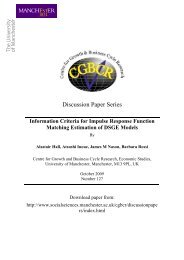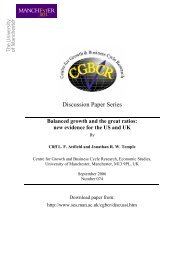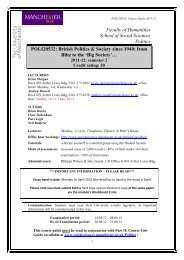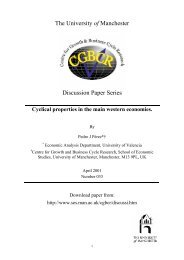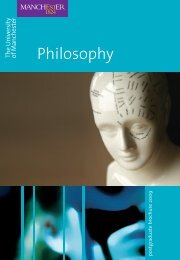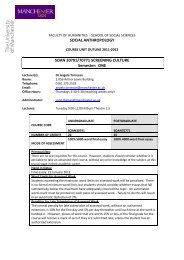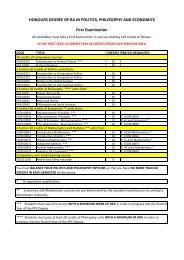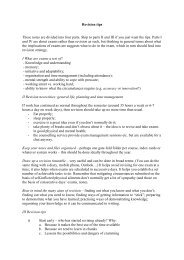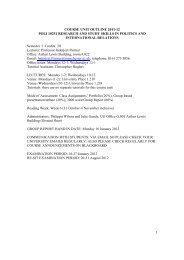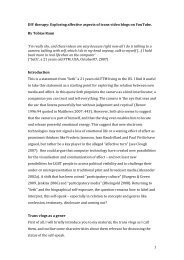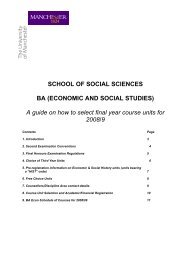CHNN 22, Spring 2008 - School of Social Sciences
CHNN 22, Spring 2008 - School of Social Sciences
CHNN 22, Spring 2008 - School of Social Sciences
Create successful ePaper yourself
Turn your PDF publications into a flip-book with our unique Google optimized e-Paper software.
and less optimistic about the prospects for an autonomous communist party, were squeezed out.<br />
The second moment was after the Sixth Congress when the potentially fruitful experiment with<br />
Workers and Peasants Parties was choked on the orders <strong>of</strong> Comintern. The third moment came<br />
with the move away from sectarianism in 1934-35, when confusion over whether ‘class against<br />
class’ had or had not been superseded meant that the CPI was slow to adjust to the new geometry<br />
<strong>of</strong> the popular front and remained wracked by sectarian quarrels for too long. The fourth moment<br />
came in 1942, when the CPI became dangerously isolated from the nationalist movement at the<br />
very moment when the latter was preparing for its greatest push against imperialism: the Quit<br />
India movement.<br />
The historical account the book gives <strong>of</strong> the debates at each <strong>of</strong> these moments is detailed, nuanced<br />
and convincing. However, the strong form <strong>of</strong> the counter-factual claim – not simply that other<br />
things were argued for, but that they could have worked better – is not defended in detail or at<br />
length. The alternatives are allowed to speak in their own words rather than analysed in depth, and<br />
their feasibility therefore remains a matter for speculation. There is also, perhaps unavoidably,<br />
some remaining mystery over exactly why each <strong>of</strong> the alternatives was dismissed. The pattern <strong>of</strong><br />
forces at each <strong>of</strong> the four key moments is arguably very different. It is too simple, and out <strong>of</strong> line<br />
with the complex historical exposition <strong>of</strong>fered in earlier chapters, to lay the blame entirely at one<br />
door. The Workers and Peasants Parties, for example, were being criticised from multiple<br />
directions before Comintern pulled the plug. True, the Comintern created confusion in refusing to<br />
admit where ‘class against class’ had gone wrong, but the CPI had arguably become a selfsustaining<br />
producer <strong>of</strong> sectarianism by this point. The CPGB too, which Pr<strong>of</strong>essor Datta Gupta<br />
suggests usually acted as the Comintern’s agent in Indian matters, invariably to poor effect,<br />
deserves a more mixed verdict. There is plenty <strong>of</strong> evidence <strong>of</strong> its failure to make an issue <strong>of</strong> India,<br />
even when it was handed one on a plate as it was over the Meerut prisoners. But much <strong>of</strong> that<br />
evidence comes from the auto-critiques <strong>of</strong> the CPGB itself, and from the carping <strong>of</strong> its political<br />
opponents. This suggests a more complicated explanation <strong>of</strong> the difficulties than simply the<br />
Eurocentrism <strong>of</strong> the party, real though this doubtless was.<br />
So the book does, as Pr<strong>of</strong>essor Datta Gupta hopes, succeed in its aim ‘to make the documents<br />
speak’. Whether the documents are sufficient to provide a ‘mirror <strong>of</strong> history’ into which Indian<br />
communism can gaze for certainty seems more doubtful. But this is to say no more than that the<br />
book is a provocation to think harder about the paths taken and not taken by communism in India.<br />
Nick Owen, Department <strong>of</strong> Politics, University <strong>of</strong> Oxford<br />
Notes<br />
1. Sobhanlal Datta Gupta, ‘The Comintern and the Hidden History <strong>of</strong> Indian Communism’, paper delivered at The<br />
Comintern and the Colonies: A Communist History Network seminar, Manchester, November 2002, <strong>CHNN</strong>, No 13:<br />
http://www.socialsciences.manchester.ac.uk/chnn/<strong>CHNN</strong>13HHI.html<br />
60



